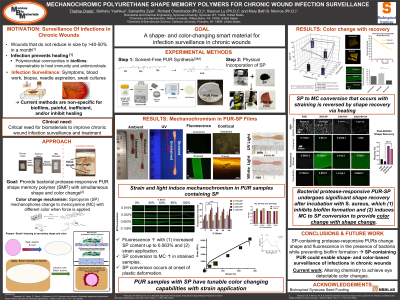Laboratory Research
(LR-036) Mechanochromic Shape Memory Polymers for Chronic Wound Infection Surveillance
Friday, May 2, 2025
7:45 PM - 8:45 PM East Coast USA Time

Bethany Yashkus, BSc. – Wilkes University; Richard Chandradat, PhD – Clarkson University; Samantha Zysk, MSc. – Syracuse University; Xiaocun Lu, PhD – Clarkson University; Mary Beth Monroe, PhD – Syracuse University
Introduction: Current clinical options for chronic wound biofilm detection and quantification are limited. Our lab developed a segmented polyurethane (PUR) shape memory polymer that changes shape in the presence of bacteria to aid in biofilm detection.[1] To improve surveillance capabilities, this study explored the incorporation of spiropyran (SP) mechanophores into the PUR. These chromogenic compounds reversibly generate optical variations in fluorescence and color due to conversion of the inactivated spiropyran (SP) to the activated merocyanine (MC) form in response to external stimuli, such as force or light, thereby acting as molecular force sensors. We hypothesized that SP-containing PUR (PUR/SP) wound dressings would undergo simultaneous shape and color changes in the presence of bacteria to give a visible biofilm cue.
Methods: Small quantities of the SP were dissolved in solutions of PURs with different hard to soft segment ratios. The PUR/SP films were formed by solvent-casting. Mechanochromic behavior was studied by heating the films, straining, cooling, and imaging using fluorescent microscopy. Dynamic shape and fluorescence change studies were carried out using confocal microscopy and dynamic mechanical analysis. The effect of spiropyran concentration on cytocompatibility was also studied.
Results: Strained samples showed increased fluorescence (up to 56%, p< 0.05), which was reversed upon shape recovery. Mechanochromic behavior of the PUR/SP films was affected by the ratio of hard to soft segment of the PUR, SP concentration, and strain amounts. However, these effects were not linear. The observed non-linear mechanochromic behavior may be attributed to the solvatochromism phenomenon. In that case, the solvent and/or the polymer matrix could be responsible for a weak equilibrium between the SP and the MC forms. Samples with the highest SP concentration were cytocompatible ( >98% viability).
Discussion: These results conveyed the potential to use SP in our PUR system as a molecular force probe, providing color-based biofilm detection in chronic wounds. Current work is focused on modifying polymer matrix chemistry to achieve more stability in force-linked equilibrium displacement towards the MC and vice versa. In the long-term, this system could be used to provide a visual cue of infection in chronic wounds to improve surveillance efforts.
Methods: Small quantities of the SP were dissolved in solutions of PURs with different hard to soft segment ratios. The PUR/SP films were formed by solvent-casting. Mechanochromic behavior was studied by heating the films, straining, cooling, and imaging using fluorescent microscopy. Dynamic shape and fluorescence change studies were carried out using confocal microscopy and dynamic mechanical analysis. The effect of spiropyran concentration on cytocompatibility was also studied.
Results: Strained samples showed increased fluorescence (up to 56%, p< 0.05), which was reversed upon shape recovery. Mechanochromic behavior of the PUR/SP films was affected by the ratio of hard to soft segment of the PUR, SP concentration, and strain amounts. However, these effects were not linear. The observed non-linear mechanochromic behavior may be attributed to the solvatochromism phenomenon. In that case, the solvent and/or the polymer matrix could be responsible for a weak equilibrium between the SP and the MC forms. Samples with the highest SP concentration were cytocompatible ( >98% viability).
Discussion: These results conveyed the potential to use SP in our PUR system as a molecular force probe, providing color-based biofilm detection in chronic wounds. Current work is focused on modifying polymer matrix chemistry to achieve more stability in force-linked equilibrium displacement towards the MC and vice versa. In the long-term, this system could be used to provide a visual cue of infection in chronic wounds to improve surveillance efforts.

.jpg)